The Coherent OBIS LG 355-20 is a self-contained OPSL laser capable of a maximum output power of 25mW of 355nm (UV-A) laser light. Similar systems are available with a maximum output power of 50mW. Much like the CUBE lasers from Coherent, the OBIS module contains all of the necessary electronics and control circuitry to operate the laser diode along with the temperature-sensitive optics. All that is needed to operate the OBIS LG laser system is a suitable DC power supply and a thermally-controlled mounting surface such as a heatsink and fan. A computer is required to control the output power over the RS-232 serial interface and monitor system parameters. Other lasers from Coherent, such as the Sapphire, require a dedicated controller board as the laser head only contains some of the components necessary for the system to function. Current-intensive functions such as TEC control and diode power are handled by the dedicated controller, while thermal control of the optics is managed by a board inside of the laser head. Coherent does make OEM controllers that can be used with this laser system such as the OBIS scientific controller or OBIS remote control unit.


According to the label, this laser system has a nominal output power of 20mW and a maximum output power of 25mW. The software reports a nominal output power of 15mW. This laser was manufactured in 2015 and has about 6000 hours.

On the front of the laser is the output aperture and mechanical shutter. The laser emission LED is located to the extreme right of the front panel next to the output window.

On the back of the laser are 3 status LEDs. The top LED is amber and indicates laser emission. The middle LED is green and indicated system status. The bottom LED is red and appears to indicate a fault condition or the laser is warming up. The USB Mini-B connector is for the internal USB-to-serial converter and uses drivers supported by Windows 10/11. The black 2-pin connector is for an external cooling fan. Lastly, the DB-26 (HD26) connector is for DC power input, interlock signals, and the RS-232 serial interface.

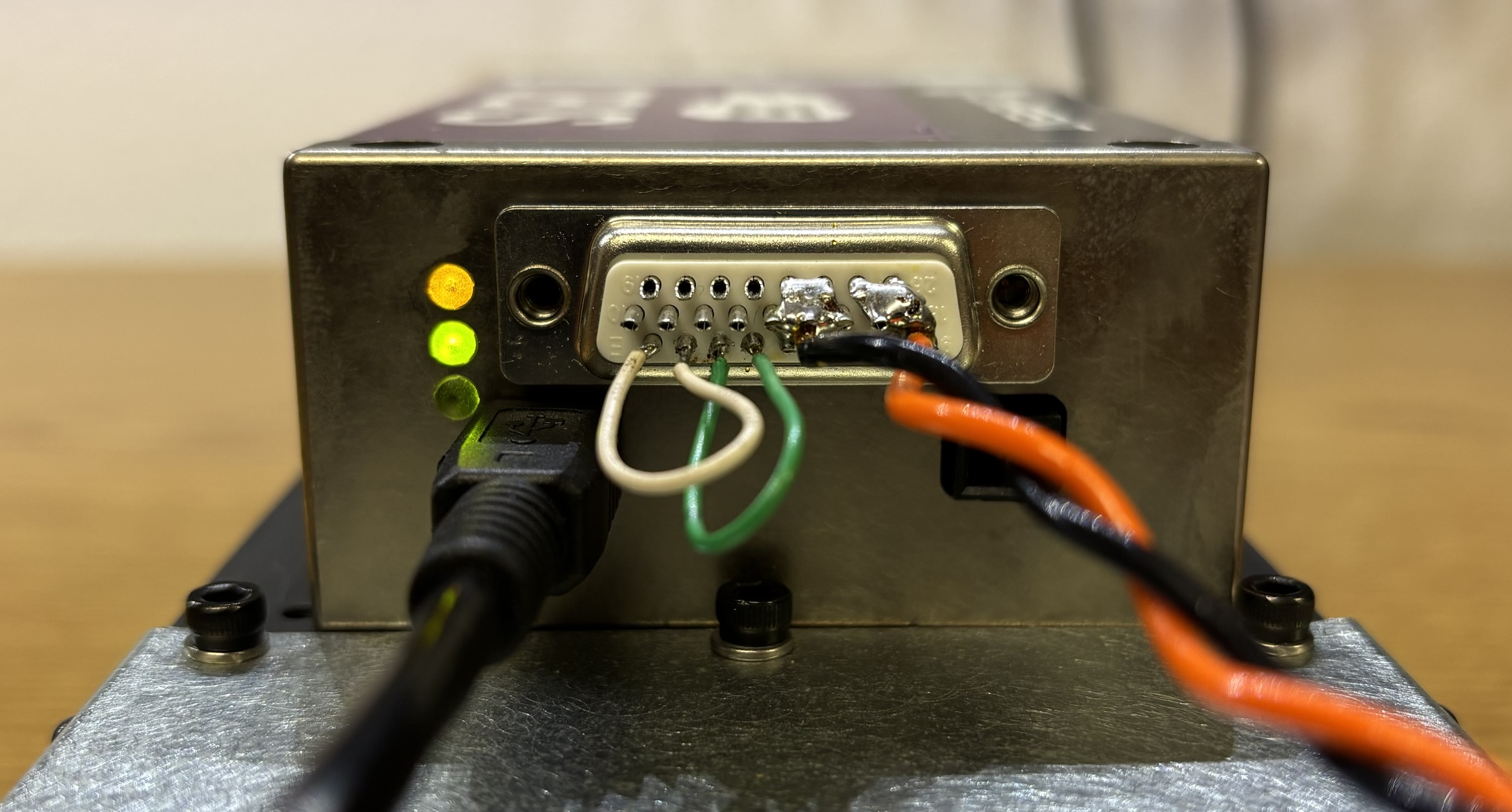
The pin-out for the DB-26 (HD26) connector can be found in the OBIS LG Integrator's Manual but has also been provided below for convenience. The OBIS LG requires 24V DC power to operate. Stay as close to 24V DC as possible as undershooting or overshooting the voltage has been known to damage these lasers. The DC power supply must also be capable of providing up to 5 amps of current.
| SIGNAL | PINS |
|---|---|
| +24V DC | 7,8,9,17,18,25,26 |
| POWER GROUND | 5,6,14,15,16,23,24 |
| INTERLOCK + | 1 |
| INTERLOCK - | 2 |
| ENABLE + | 3 |
| ENABLE - | 4 |
| USB + | 10 |
| USB - | 11 |
| USB VCC | 22 |
| GND (RS-232/USB) | 21 |
| RS-232 RX | 19 |
| RS-232 TX | 20 |
The wavelength of light produced by this laser system is in the ultraviolet spectrum and is not visible to the human eye. Glow powders or other fluorescent substances/materials are an excellent way to view the laser output. In the image below, the phosphors contained within paper sticky notes fluoresce a vibrant blue when exposed to the 355nm beam. Use caution when operating units like this, lasers that operate outside of the visible light spectrum can still cause permanent eye damage, and are especially dangerous since you cannot easily see the beam.
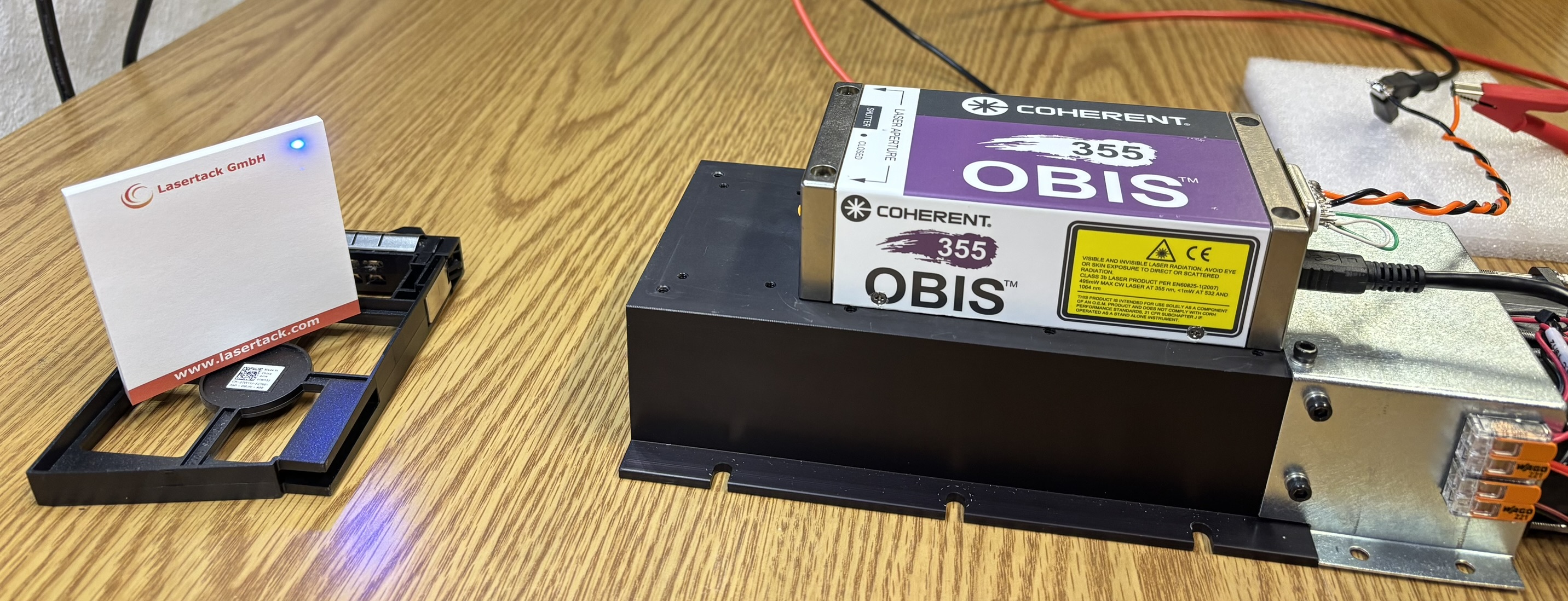
Removing 2 screws on each side of the cover (4 total) reveals the internal components of the OBIS LG. The actual laser diode and optical components are located under a metal cover that is soldered to the bottom circuit board. This optical cavity is hermetically sealed and filled with an inert gas such as nitrogen. On the front of the sealed enclosure is an optical window that filters out infrared and green wavelengths of laser light and allow others to pass though. There are 3 total circuit boards contained within the OBIS LG laser system. The board that runs parallel to the optical cavity is the control and driver board which provides power to the pump diode and precise control over the temperature-sensitive components contained within the optical cavity. The boards mounted to the rear of the housing are responsible for power conversion (DC-DC converters) and interfacing/communications.

With the boards and rear panel removed, we are left with three DC-DC converters mounted to the bottom circuit board. Other OBIS models we worked with had the DC-DC converters located on the board mounted between the optical cavity and rear connections board.
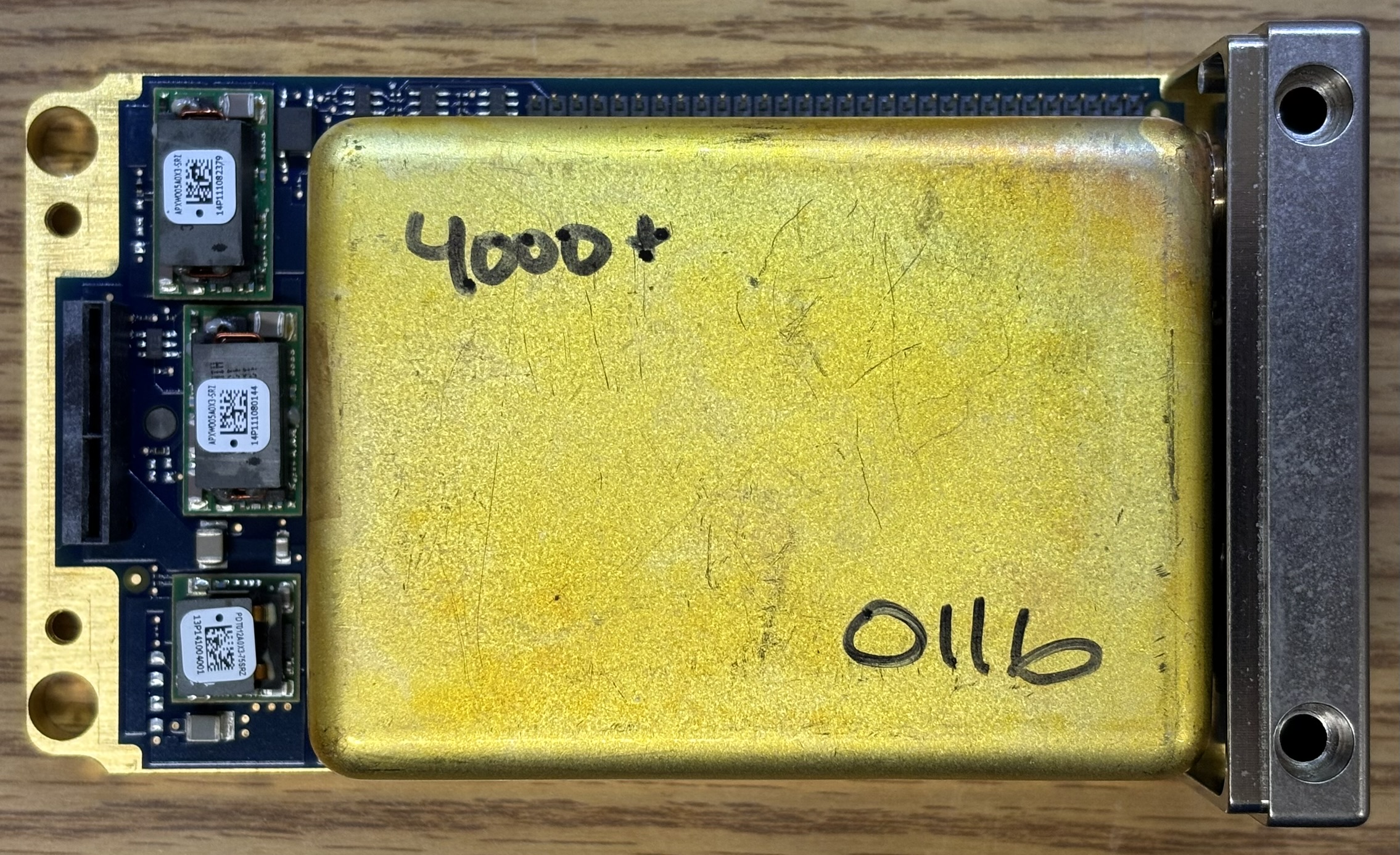
Under the hermetically sealed cover are the actual optical components and pump diode. The majority of the components are further protected by a metal casing, but some filtering optics and lenses can be seen at this point. Take note of the flat-flex ribbon cable that connects the diode and temperature control/sensing components to the bottom circuit board.

Below is an image of the inner optical cavity. The colored lines correspond with the beam path. Since this is an OPSL laser, light emitted from the pump diode is filtered through a lens and then reflects off an OPS chip, converting the wavelength. The wavelength is further converted by second and third harmonic generation optics that follow. It is worth noting that both 532nm and 355nm light is produced by this optical assembly, however, the 532nm (green) light is filtered out before it leaves the laser head. This results in 355nm being the only wavelength emitted, which is the intent of this OBIS LG model.
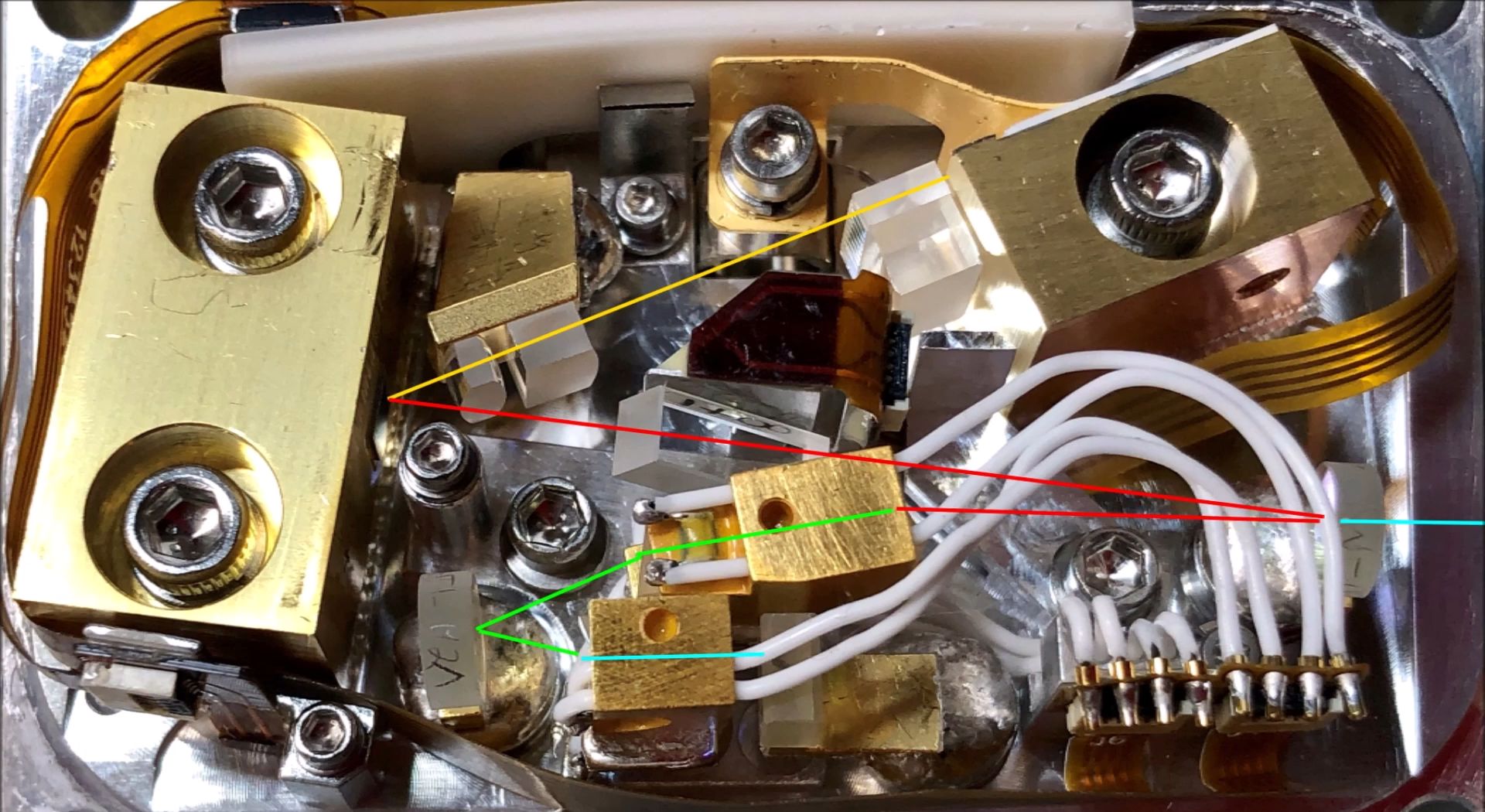
Here is an annotated image that describes the beam path of the OBIS LG 355nm laser system.

This is the OBIS LG diode driver and temperature control board. It supplies the necessary current to the laser diode. It also regulates the temperature of the sensitive optical components (SHG, etc.)

Here are some pictures (from a different OBIS unit) of the front and the back of the power regulation board. As mentioned earlier, the DC-DC converter modules are mounted to the intermediate board inside of the bottom circuit board in this particular OBIS unit. The two large capacitors help smooth out the DC voltage.


This board breaks out the DB-26 connector on the back of the laser head to the internal circuit boards. It also has a section that slots into a card connector on the bottom circuit board.
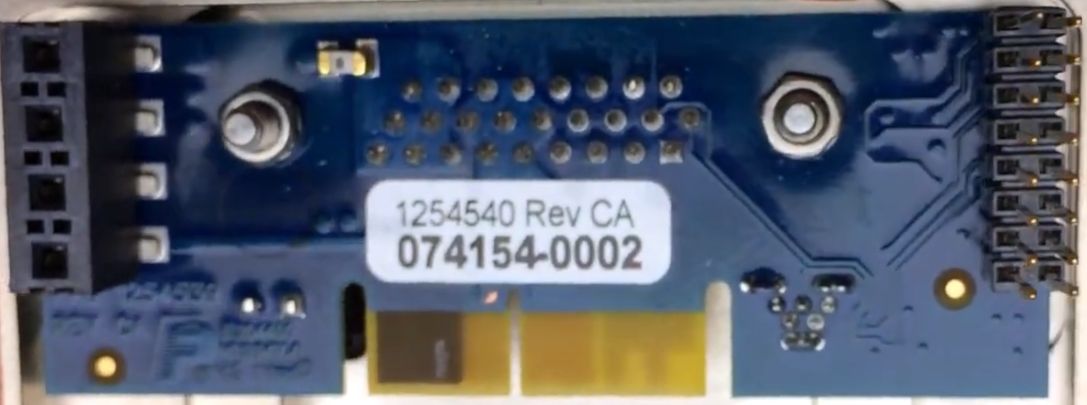
Establishing serial communication with this laser system is relatively straightforward. The default serial communication parameters are specified below and can also be found in the OBIS LG Integrator's Manual. Please note that command handshake is enabled by default. Refer to the Coherent OBIS LG Laser Systems Integrator's Manual for the full table of serial commands, as it's quite extensive.
- BAUD RATE: 115200
- DATA BITS: 8
- PARITY: NONE
- STOP BITS: 1
- FLOW CONTROL: NONE
Please check out Patrick's detailed video about the Coherent OBIS LG 355nm OPSL laser. To learn more about OPSL lasers and the OBIS LG, visit the links below.